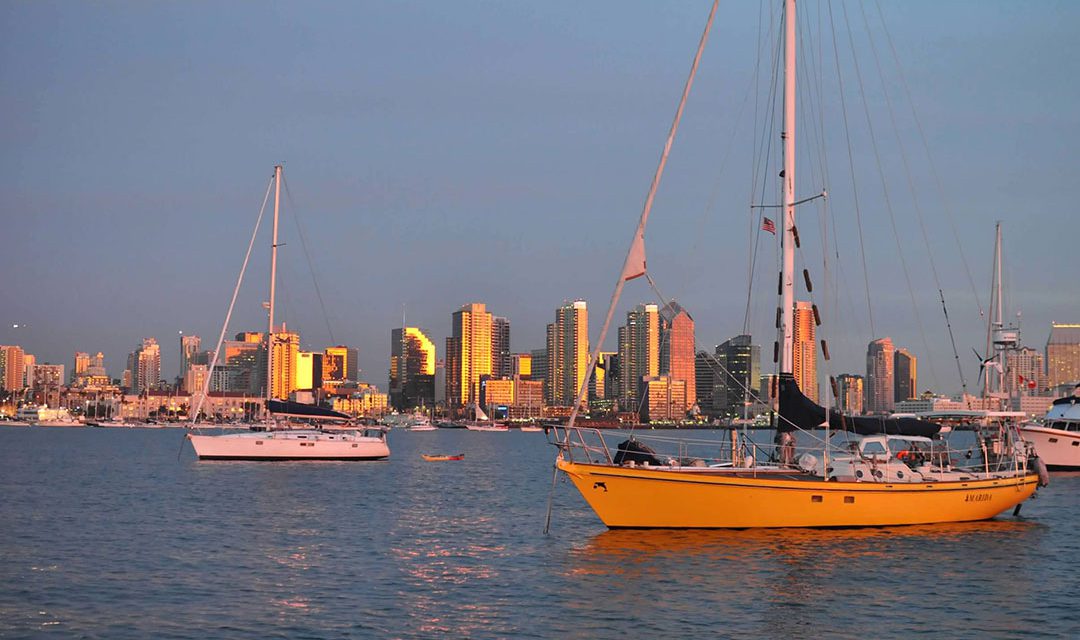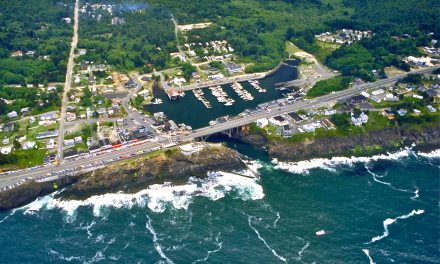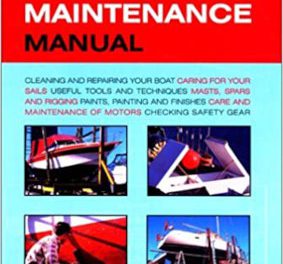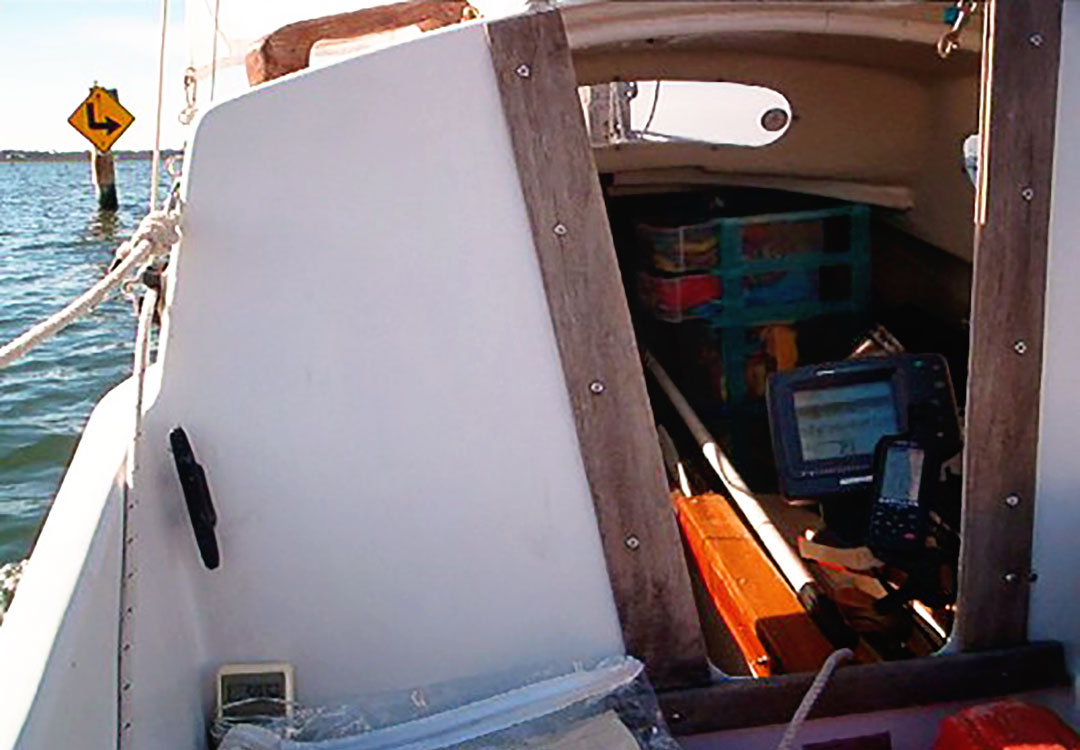
At the end of a 1,000-mile voyage from Maine to the Outer Banks in his wood-sparred UK Potter 14, Potter Gus, Peter Cash began seeing odd navigation aids, this one in North Carolina’s Core Sound.
More Words on Electrification
I have read through the reader letters in response to your question about electric propulsion and I want to offer one more point that I think was addressed only tangentially in those letters.
If I’m caught off a lee shore in a squall (or worse, a gale that didn’t stick to the forecast script), I want to know that I have sufficient power reserves to claw my way out of danger. An electric motor with an hour’s capacity is fine for getting in and out of the slip, but sailors don’t set up our boats for average, predicted conditions. The key to safety is to be prepared for the outliers. Our rigging is not rated just for average winds, and we have reef lines in our sails that we may never use. When the situation gets tense, I want to have an over-engineered boat that I can count on. At this point for me, that still means an iron genny with a big tank of fuel and redundant filter systems.
—Alfred Poor, 1973 Tartan 34C #288, Jambalaya
Thanks Alfred, yes to all. And for offshore sailors especially, redundancy and self-sufficiency and over-capacity are all accepted maxims. But where do you draw the line? We think it’s okay set sail without “an iron genny with a big tank of fuel,” so long as you’re setting sail knowing you don’t have an iron genny and a big tank of fuel. When you do, you’re likely to sail differently, with that limitation in mind. Just based on our anecdotal knowledge of case histories, we don’t think that insufficient power or the inability to power for a long enough duration is the cause of most lee-shore wrecks (and we acknowledge that that’s just a single example you used to make your point). Empirically, we know sailing with just in-and-out-of-the-harbor-capacity electric propulsion can be done safely and reliably. Case in point, Webb Chiles recently finished sailing around the world in a Moore 24 with a Torqeedo outboard (about 3 horsepower, full-throttle run time of maybe 20 minutes) as his only means of non-sail propulsion. Also, as we hope to reveal in the May/June issue of Good Old Boat, electric propulsion has come a long way (and still has a long way to go) and some of the most common systems are hybrid systems that keep diesel as part of the equation, and provide plenty of runtime (when needed) to get you off that lee shore in a gale. Stay tuned.
Michael Robertson
The Cost of Keeping Her Someplace
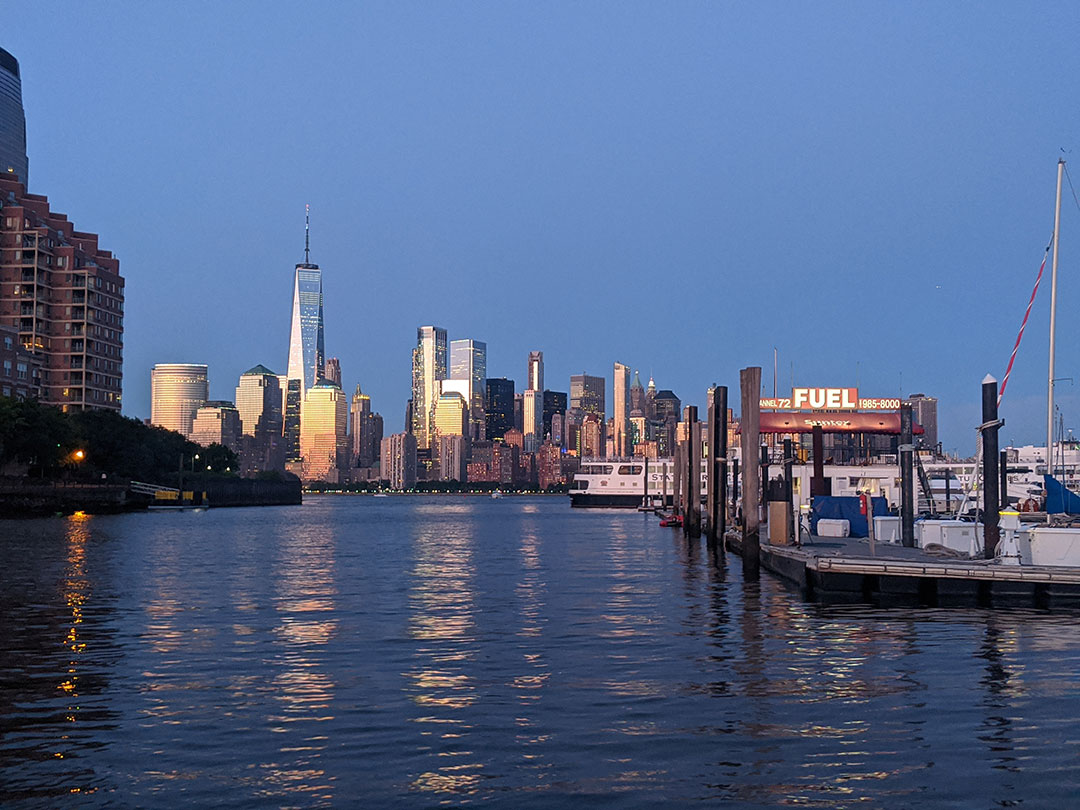
Last month, I put it to readers about the cost of keeping a boat in a slip or mooring, about how that cost might differ (dramatically) geographically. I was prompted to ask because I’d recently been shocked to learn from a reader that it would cost at least $9,000 to keep a 38-foot sailboat in a slip in New England for a single 6-month sailing season—provided that sailor could even find a slip. To add insult to injury, that cost did not include electricity. I related my own slip- and mooring-fee experiences over the past couple of decades, and I wanted your take.
I quickly got the take of one New Jersey liveaboard and Good Old Boat’s master Creative Director, Kelley Gudahl, who lives aboard with her husband and daughter on their 42-foot sailboat. See that view in the pic above, of the Manhattan skyline? That’s the view from Kelley’s cockpit. Cost: $1,130/month, electricity metered separately. But as Kelley says, “Sailing by the Statue of Liberty every time we leave port isn’t too bad.”
Bottom line, seems to be more expensive to keep a boat in New England than other places in the U.S.
I’m going to give John Kettlewell the first word, he shares some practical information…
—Michael Robertson, Editor
***

Just to give you a rough idea of dockage rates around New England, per this screenshot, it would be around $9-10K per 6-month season for me to keep my 38-foot boat at a dock, if I could even find a slip, many marinas have no openings. I have tied up next to megayachts at Bahia Mar in the middle of Ft. Lauderdale and paid less for a night than it would cost me to rent a floating mooring ball for one night in some New England harbors. The Carolinas are the cheapest. The Chesapeake has some reasonable dockage, and then the rates climb steeply as you go up the coast. Maine is up and down, but overall I would say it is more costly than much of the Chesapeake.
I’ve put together a list of New England marinas and their rates, all for what is generally a 6-month season. It is highly variable depending on location. In my experience, finding a seasonal slip is extremely difficult. Here on Martha’s Vineyard, I am on multiple waiting lists for a mooring ball location, with it looking like about a 10-year wait.
- East Greenwich Marina, East Greenwich, RI: $135/foot for larger boats,
- F.L. Tripp & Sons, Westport, MA: $130/foot plus $350 electric
- Prime Marina, Vineyard Haven, MA: $232/foot, plus taxes and fees
- Pope’s Island Marina, New Bedford, MA: $90/foot, plus electric I believe
- Constitution Marina, Boston, MA: $209/foot with electric
- Port Harbor Marine, Portland, ME: $130/foot
- Boothbay Harbor Marina, Boothbay, ME: $77/foot plus $400 for electric
- Rockland Landing Marina, Rockland, ME: $2675 (June-Sept)
—John Kettlewell, 1978 Finnsailer 38, Vineyard Haven, Massachusetts
I am in Atlantic Canada, Southeast New Brunswick. For a 34-foot boat, slip fees for our short, 4-month season (in on May 27, out by early October) range from $1,450 at Cap de Cocagne (at a marina with basic service and dated finger piers inside a wharf) to maybe $2,700 (at one of the fancier marinas in Shediac Bay). If I was to go further up the coast, say another half-hour, we could probably get a berth for around $1,000 or less.
I bought my boat in New England in 2009 (Maine) and stored it before shipping it north, so I have a sense of how expensive it can be.
—John Sims, Southeast New Brunswick
We stayed on our Cal 35-2 for 2 summers (2015 & 2016) in downtown Boston on a mooring and paid about $3200 each season (May 1 to Nov 1). If we’d chosen to be at a slip, we’d have been charged triple that amount!
During the low season (from Nov 1 to the end of April), we could have stayed on the dock for $3200.
—Ed White, Caliente, Hull, Massachusetts
I just read your note about expensive mooring/berthing fees in New England and it really hit a sore spot. I retired to Cape Cod 15 years ago, after a lifetime in the Midwest with my boating confined to rivers and lakes. I looked forward to finally doing some real open-water sailing. I quickly lucked into a mooring for my Catalina 27. It wasn’t cheap, but I felt lucky to get it so I bit the bullet. Well, I’ve had to bite that bullet harder each year as the mooring fee has gone up every year since then, by about $200-$300. I am getting near the point of giving up the boat. It now costs me about $5500/year for the mooring, winter storage, and insurance; I do all my own maintenance, winterization, bottom paint, etc.
With my advancing age and some medical issues with my wife, we are transitioning to a 40-foot trawler that I found in Michigan. When I started looking at getting a slip here on Cape Cod for the trawler, I found that the best I could do was, as you found, about $9,000 for a season (no winter storage). By comparison, I can get a full-season summer slip and inside winter storage for the trawler in Michigan for about 2/3 of just the summer slip expense here. So, we’ve decided that the trawler will eventually live up on Lake Champlain (where the Vermont-New York-Canada borders intersect). It’s not cheap up there, but still considerably better than here.
Why is New England so expensive? I can’t really explain it beyond the area being just more expensive in general. Maybe it’s the ‘aura’ of New England (this midwestern boy does love it here…)? Perhaps another explanation is simply demand, because boating is such a huge industry here—but that argument should then be supported by high costs in other popular boating areas. It hurts to write the checks, but a good day on Vineyard Sound helps ease the pain!
Good work with the magazine and building on what Karen and Jerry started!
—Joe Chronic, Sleigh Ride and m/v Serena
I keep a 32-foot sailboat in a New Jersey marina with a view of downtown Manhattan. I pay more than $10,000 annually (I pay my electricity directly to the local utility; rarely more than $15 per month).
We’re talking about the northeast United States. The high population density and some of the richest per-capita counties in the country, the cost of living is sky-high. Despite the region’s sailing reputation—or perhaps because of it—marina space for year-round and transients is high-demand/low supply. Capitalism 101 gives you your answer. In the region, as elsewhere, waterfront property values are dear and developers can make more money on luxury housing than on marinas. Marinas and mooring fields are full in the summer sailing season and the cruising sailor must carefully choose their spots at local anchorages, get there early, and watch where others drop their spikes.
More than ever, those who choose the boating or sailing lifestyle are willing to make sacrifices in order to do so. That said, liveaboards and stay-aboards in the New York area are discovering that the purchase of a decent old trawler, perhaps not even a seaworthy one, and a $12,000 per year dock rental is a bargain compared to what can be found in the regional apartment marketplace. Wintering aboard is a hardship, but that hardship is an increasingly acceptable sacrifice for a younger, more adventurous generation who are being priced out of decent affordable housing.
—George Bailey, Intended Consequence, Catalina 320
Thank you for your thoughtful analysis, George, and you may be right, but we’re not satisfied. New England doesn’t lead the country in either expensive zip codes or the per-capita number of boat registrations. Geography and environmental regulations make it impossible to add to the number of slips available to serve a growing West Coast population, and mooring fields are few and far between because of geography. Yet costs are comparably dirt cheap.
All up and down Southern California, nice floating concrete slips are available (easy to get) for the entire year-round sailing season at less than the cost of a slip for a 6-month sailing season in New England (for which you would still have to pay for winter storage). We found even cheaper slips available in the Bay Area up north (non-liveaboard slips, as we think liveaboard capacity is maxed out)—like $400/month ($4,800/year) for a 40-foot slip on a floating concrete dock with locked gates, security, parking, metered electricity, and keyed-access bathrooms with showers.
Michael Robertson
I went to look at a trawler in Fort Pierce, Florida, and I was told that if I purchased it, the slip would go to me. There were no empty slips available in this marina. Cost would be around $550/month, plus utilities.
Up until 2018, I kept a 31-foot sailboat in a slip at a privately-owned marina for about half of this price, but it was a lonely place—lots of boats, no people, and over an hour to the inlet if I caught the bridge opening.
I think that there are just too many of us boaters, and that the price of waterfront property has risen due to the demand for real estate with views of the water. Of course, the people who buy these homes do not want to see a boat anchored in “their” water.
Today, I “sail” a kayak. I used to take it out on weekdays and enjoy the solitude, but since the pandemic hit, everybody is on the water all week long because they can’t go to work.
—H.B. Koerner, Vero Beach, Florida
I keep a 36-foot sailboat at Maine Yacht Center in Portland. Fees for May 15-Oct 15 run about $5,000, which includes shore power, water, and plenty of dockhands to help entering and exiting the slip. We have onsite pump-out, diesel and gas, clean showers, laundry, some indoor parking, and a service facility that can completely refit any yacht. It is a superb facility and about half the $9,000 price you cited in your query.
—Stephen Gaal, Portland, Maine
Stephen, it sounds like a superb facility, and the rates are indeed almost half of what your neighbors to the south are paying. But your data point still supports our thesis, and we’re going to refine it a bit, as it comes into focus. So, here it is: It’s much cheaper to keep a boat in the year-round sailing locations of the U.S., than it is to keep a boat on the northeastern seaboard where the sailing season is only 6 months.
More glaring evidence to support our assertion:
For about $900 less than what you’re paying in Maine to keep your boat for 6 months, you can keep your boat all year round in Alameda, California, and with all the same amenities you list.
To all those on New England moorings:
It costs about $150/month to keep your boat on a mooring year-round in San Diego Harbor, California. Granted, the waiting list is long. We paid $75 to get on the waiting list in 2013 and it took just over 3 years for a mooring to open up. I took this photo of the $150/month (year-round) mooring field and the San Diego skyline beyond, anchored about ¼-mile from the mooring field.
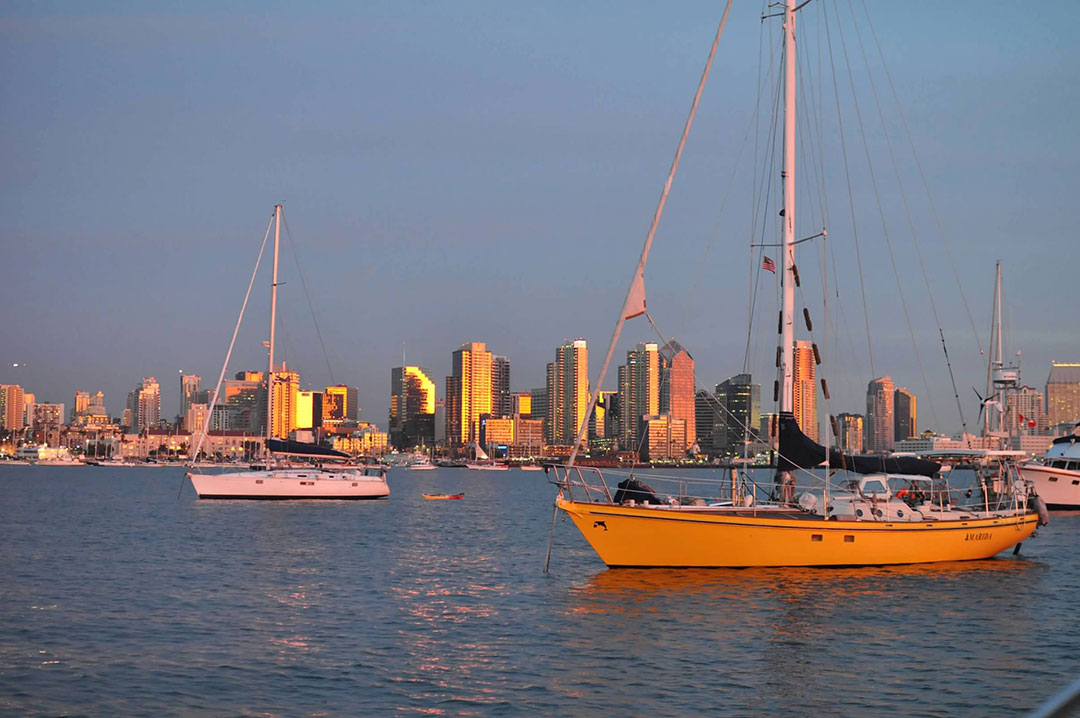
The cost disparities are too great to stand up to any explanation we’ve heard.
–Michael Robertson
I have lived aboard a couple places in the New York area: in Manhattan in the 1990s and later in Port Washington, on the Long Island Sound. Back then, I paid a little over $200/month for a 39-foot boat. There were showers and no water in winter. Today, I think the rate is about $200/foot/year.
In October, I bought a 37-foot ketch in Baltimore and decided to keep it there for the winter. I pay $100/month for the slip she’s in. It would cost six times that amount to keep the boat nearer to me.
To keep even a 20-foot sailboat on a mooring at the least-expensive place I know in New York costs $1,000/month for summer and then another $700/month for winter storage.
I’m a lifelong sailor with a 50-ton license and I don’t really know why I have a boat any more. The costs are debilitating. I believe, after years of keeping that plate in the air through determination and a steadfast refusal to face the facts, I may have to let it fall.
—Duncan Raymond, Yonkers, New York
Here on the southwest coast of Connecticut, on the Long Island Sound, boat slips rent out at exorbitant rates and moorings are the less-expensive alternative. If you are on a mooring without launch service, you will likely also need to rent a place to tie up your dinghy. In addition to my mooring fee, I pay $750/season to keep my dinghy in a dinghy tie-up pen that is over-rented and as jam-packed as possible. That fee includes a car parking permit and the ability to use the dock for short periods (like 15 mins, but there is seldom a space open to pull up to).
Back in the good ole days, southwest Connecticut’s shoreline was full of boat yards, slips, and marine services and the cost of keeping and maintaining a boat was more manageable. Over the years, most of our boat yards and access to the waterfront has been lost to development and the private use of multi-million dollar condominiums, prestigious office space, restaurants, and, to a lesser extent, individual residences. So as boatyard owners gradually cashed out, the balance of supply and demand became skewed, leaving boat owners with considerably lighter wallets.
—Steve Mason, Five Mile River, Rowayton, Connecticut
I can’t offer any direct information on slip costs in New England, because I have always been on a mooring. Twenty-three years ago I moved from Massachusetts to East Greenwich, Rhode Island. After 2 or 3 years on the town mooring waiting list, I was granted permission to sink a mooring. The town’s harbor master regulates where moorings are located, but the boat owner must buy and manage their own hardware. I don’t recall the cost of the hardware and town mooring permit 20 years ago, but a few years ago I was paying $165/year for the permit. I had to pay a couple of hundred dollars to have the hardware pulled and inspected every few years, but the total cost was well worth it.
Back in Massachusetts we knew a couple who lived aboard a 42-footer year-round in Salem. I don’t recall the cost, but spending the New England winters onboard with the condensation and cold walks to the shower is beyond what I could imagine, even if it was free.
—Ed Lawler, Richmond, Rhode Island
I am sure you can pay $9,000/season for a slip if you look hard enough.
We keep our powerboat at the Pattaconk Yacht Club in Chester, Connecticut. A 39-foot slip can be had for the season for $1,834—including power/cable/wifi. It’s not popular with sailors because it’s a long ride down the river to Long Island Sound.
Following are the rates at two other marinas surrounding the Long Island Sound.
Burr’s Marina in New London, Connecticut charges $39/foot for the season plus $130 for electricity. For our 39-foot boat, would cost $3,757 for the season.
Nearby, Pine Island Marina charges $108/foot for the season (and electricity is included), adding up to $4,212 for our 39-foot boat.
—Jim Long, Chester, Connecticut
Thank you for the perspective, Jim, these do sound like more affordable options. However, the pretty Pattaconk Yacht Club doesn’t seem like a fair comparison, given, as you acknowledged, the 2- to 3-hour motoring trip from the river to the sound just to pop the sails (and then the same motoring trip back to your slip).
The other two marinas seem like much more viable options—and definitely more reasonably priced than what others are paying nearby—but they’re still far more expensive than West Coast options. Comparing apples to apples, you’ve cited rates that range from $93/foot to $108/foot for 6 months. Compare that to rates that range from $60/foot to $90/foot for 6 months. Those latter rates are for 40-foot slips in large marinas in Alameda (Bay Area) and Ventura (Southern California).
Go figure.
Michael Robertson
I keep my Sabre 32 in Rock Hall, Maryland. For the 2021 season (4/15 – 11/15), a 40-foot slip is going for $5,500. This includes unlimited electric via 30-amp hookup, unlimited water, dock box, access to pool and free bath house, bikes, and kayaks. A monthly slip is $1,200.
I have a friend who lives in Warwick, Rhode Island. He can have the town install a mooring for $1,500 and pay a $100/year fee thereafter. I am insanely jealous of this.
—Andy Bohne, Chester Springs, Pennsylvania
I keep my Coronado 35 in Bayfield, Wisconsin, gateway to the Lake Superior Apostle Islands. My slip rental from mid-May to October is $4,200, which includes electricity, wi-fi, shower facilities, and a nice lounge.
—Mike Montesinos, Gypsy Spirit
For a single night, transient slip in Sausalito, California, it costs $68. Granted, the docks are in excellent condition and water and electricity and restrooms are included. Everything in Sausalito is expensive, everything. Nice place though!
—Robert F. Neefus, Arcata, California
Robert, we know of what you speak: we were married at the Sausalito Women’s Club a couple of decades ago. Lovely and expensive town. But, consider how inexpensive that $68/night is when a transient slip at Kelley’s marina (see my text at the start and the view of Manhattan) is over $250/night.
Michael Robertson

